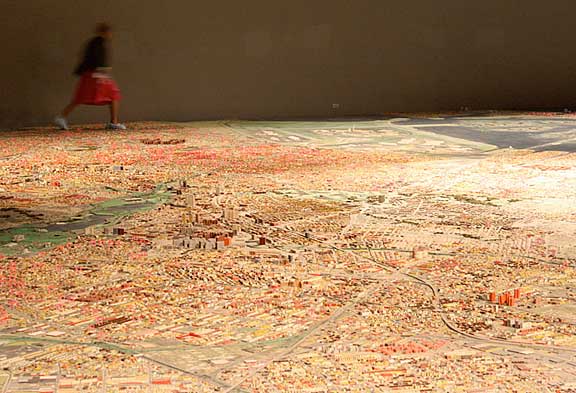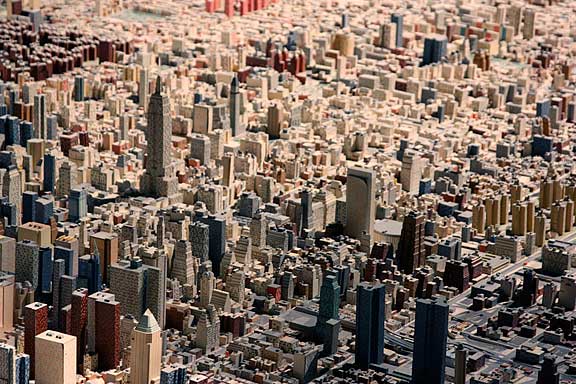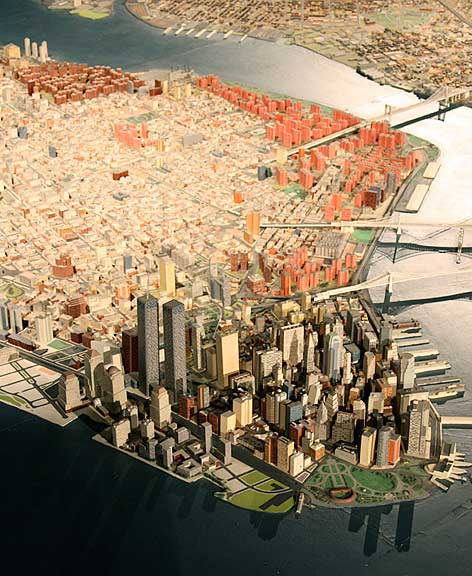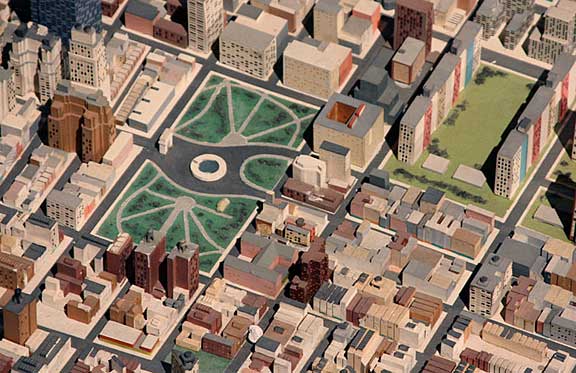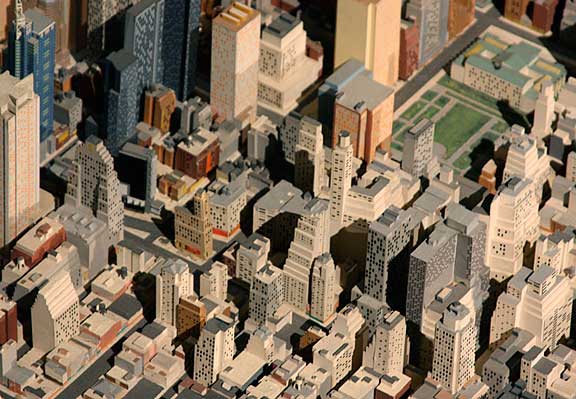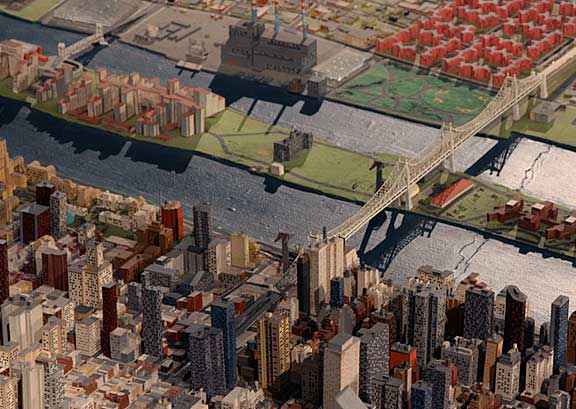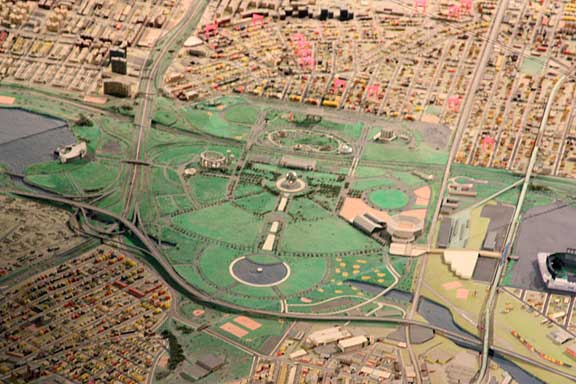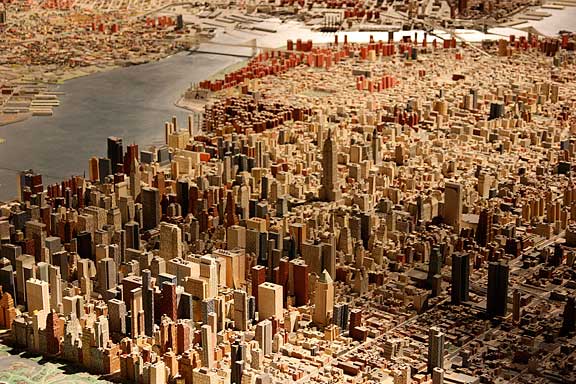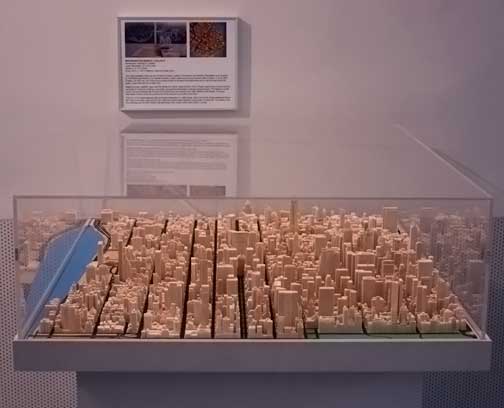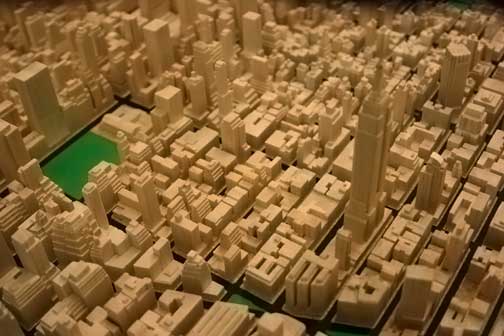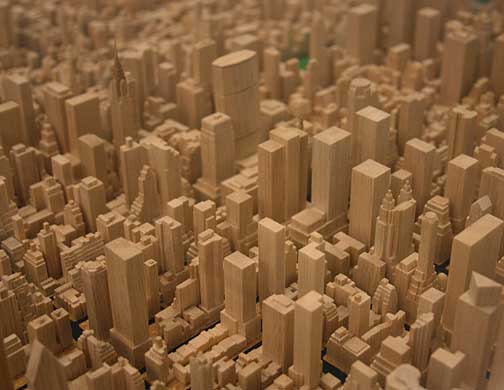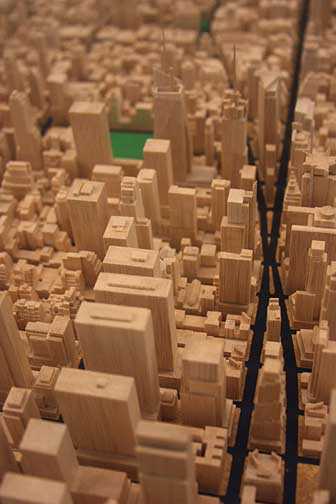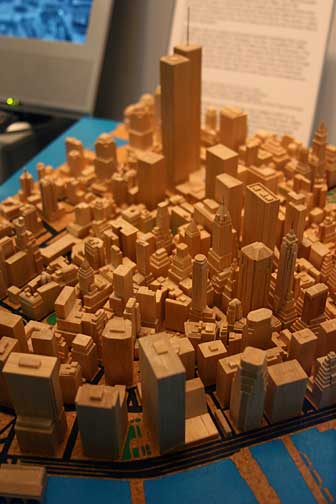|
The Queens Museum of Art houses the world's largest architectural model, which depicts all of the buildings in the entire city of New York. Entitled the Panorama of the City of New York, the model is built at a scale of 1:1200 (one inch = 100 feet) and covers 9335 square feet of exhibit space. It is the largest scale city model in the world, despite the unresearched claims by many bloggers for the city model in Shanghai.
The Panorama was originally built as a featured exhibit for the 1964 World's Fair. Over 100 craftsmen worked for nearly three years to build 830,000 tiny buildings from wood and plastic. They used insurance and plat maps, aerial photos, as well as direct observation, to build the most accurate representation of the city possible, including all five boroughs, and the entire length and breadth of the city (aside from a corner of Far Rockaway which would not quite fit the space). New York's master planner, Robert Moses, conceived the idea of a model as a tourist attraction for the 1964 fair, to be later used as a regional planning tool to show public works projects.
Originally the Panorama was viewed from small cars which ran on tracks above the perimeter of the room. The ride was an imaginary helicopter tour, with famed travel writer Lowell Thomas providing an audio guide of the notable sights in each borough.
Like the intricate axonometric maps drawn by hand by Hermann Bollman in the 1950s and Constantine Anderson in the 1980s, the mass of blocks and tiny windows of Midtown Manhattan merge into an overwhelming visual jumble. It astounds the visitor to think how this magical little world was created by hand from so many little pieces.
Scale models like this allow the viewer to understand how the city is put together, in ways that are not obvious from walking the streets. It is the same reason that tourists enjoy visiting observatories at the top of skyscrapers: to gain a framework of understanding one's experiences in a place that is so large as to seem a disconnected series of streets and spaces. Whether it is simply for the tourist to string together a narrative of a short visit to the city, or for the New Yorker to understand how his/her neighborhood fits in to the whole, these are exactly the purposes for which Robert Moses imagined the model.
The Panorama has been updated and altered along with new construction in the real city, but since the construction boom of the 1990s, the model has lagged behind reality. Some of the little buildings seem to be tattered and falling apart in places. Simply maintaining and preserving the hundreds of thousands of buildings in the model must be a constant challenge against dust and occasional detritus dropped from the balconies above. A monstrous lump of chewing gum can be seen in the park not far from Washington Memorial Arch in the photo above.
Though the model buildings are built to accurate scale and position, if you look carefully at each one, there isn't a lot of detail. Most of the windows are depicted as punch-card style grids, whether the building is a minimalist tower block or an old-fashioned beaux arts apartment house. Sharp-eyed viewers may spot odd anachronisms. Look carefully at One Times Square just left of center in the photo above. Is this a model of the original gothic skyscraper before 1961, when it was redone as a modernist box stripped of its windows and covered with advertisements?
The model is filled with charming details, like the tiny cable cars going across to Roosevelt Island, just north of the Queensboro Bridge. I expected the tiny cars to move, like train cars on a model railroad layout. There is one mechanized feature of the Panorama: tiny airplanes on wires which rise steeply from the LaGuardia airport runway, round a pulley hidden in the rafters, cross the sky above, then turn down for a quick landing again. The tiny shadows of the airplanes moving across the city are a subtle effect that adds a quiet mystery to the model.
For that 'meta' effect, you can look down on the site of the 1964 World's Fair, and see the building which houses the Panorama. Its there, across the street from the Unisphere globe. Can you imagine yourself inside, less than 1/16th-inch tall?
At a scale of 1:1200, the Empire State Building is about 12 inches high. Across town, at the Skyscraper Museum, there is another scale model depicting a section of New York. This one is much smaller in scale and in scope, depicting only a small part of Manhattan. Michael Chesko created a model of midtown Manhattan and another of lower Manhattan, at 1:3200 scale, from pieces of carved balsa and basswood.
While these models lack the realistic colors of the Panorama model, the simplicity of the natural wood finish gives the model an elegance and beauty lacking in larger models. The tiny avenues invite us to wander along in our imaginations, and trace the streets we followed to arrive at the museum near Battery Park.
The unpainted wood of the model creates a unity from the jumbled forms of the real city, as if the dense skyscrapers were natural objects growing in a miniature forest.
Amazingly, the artist never visited New York before building these models. Using only maps, aerial photos, and reference data found online, he spent more than 2000 hours constructing each of the two models.
The micro scale of tiny wooden details gives the model a delicate beauty that must be seen in person to fully appreciate. Stop by the museum to check it out for yourself!
Visit other miniature scale model cities around the world. |










